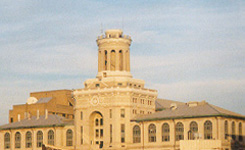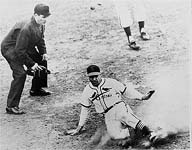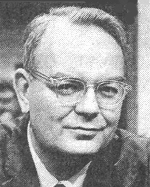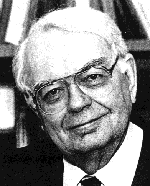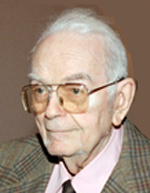Tales of Statisticians
Frederick Mosteller
24 Dec 1916 (Clarksburg WVa) - 23 July 2006 (Falls Church, Virginia)Mosteller was born in West Virginia, but the family soon moved to a series of homes in the vicinity of Pittsburgh. His parents were presently divorced. With guidance from his mother, and with money saved by working summers on highway building with his father, where he also honed his poker skills, he went to Carnegie Institute of Technology in Pittsburgh.
There, in due course, the following occurred:
A key moment in my life occurred in one of those classes during my sophomore year. We had the question: When three dice are rolled what is the chance that the sum of the faces will be 10? The students in this course were very good, but we all got the answer largely by counting on our fingers. When we came to class, I said to the teacher, "That's all very well - we got the answer - but if we had been asked about six dice and the probability of getting 18, we would still be home counting. How do you do problems like that?" He said, "I don't know, but I know a man who probably does and I'll ask him." One day I was in the library and Professor Edwin G Olds of the Mathematics Department came in. He shouted at me, "I hear you're interested in the three dice problem." He had a huge voice, and you know how libraries are. I was embarrassed. "Well, come and see me," he said, and I'll show you about it." "Sure, " I said. But I was saying to myself, "I'll never go." Then he said, "What are you doing?" I showed him. "That's nothing important," he said. "Let's go now."So we went to his office, and he showed me a generating function. It was the most marvelous thing I had ever seen in mathematics. It used mathematics that, up to that time, in my heart of hearts, I had thought was something that mathematicians just did to create homework problems for innocent students in high school and college. I don't know where I had got ideas like that about various parts of mathematics. Anyway, I was stunned when I saw how Olds used this mathematics that I hadn't believed in. He used it in such an unusually outrageous way. It was a total retranslation of the meaning of the numbers. [Albers, More Mathematical People].
This encounter saved Mosteller from engineering, for a career in statistics. After Carnegie he went to Princeton in 1939, part of his education there being the toughening process which is required of a statistician among pure mathematicians. Another part consisted of helping Sam Wilks as editor of the newly founded Annals of Mathematical Statistics. While at Princeton, he married Virginia Gilroy, with whom he had shared streetcar rides back in Pittsburgh.
In 1941, WW2 having begun, Mosteller was taken into the Fire Control Research unit, and eventually into Wilks's Statistical Research Group, calculating such things as the dispersion of a string of bombs. It turned out that, out of many variables, the best predictor of bombing accuracy was the amount of fighter opposition. This was because no variable for cloud cover had been provided: the enemy fighters were grounded, but the bombardiers were also hampered, by cloudy weather. Another young member of the group was Jimmie Savage, who like Mosteller was impressed with the Bayesian or personalistic approach to statistics. The two did a joint paper, which resulted in a writing lesson:
"Jimmie and I wrote a long paper together for the Statistical Research Group of Columbia, and had a lot of fun doing it. We were also rather pleased with ourselves for the way we had written it. Allen Wallis gave our manuscript to the executive director of the project, Milton Friedman, then a statistician but best known today as an economist. Milton took the paper home over the weekend and sent it down to us on Monday. We could scarcely believe what he had done to the manuscript. Hardly a line was unchanged. The pages were black with corrections, and the backs full of extended notes and rewriting."
"Jimmie and I held an indignant meeting of the "He can't do that to us" variety, and we studied the literally hundreds of suggestions that had been made. The more we worked, the more we found that Friedman was occasionally; well, often; let's face it; usually right. We finally made a list of 100 or so objections to Milton's changes and went up seven flights to do battle with him. Milton was just delighted to see us. In no time he showed us that he was right in about 85 percent of the objections. He gave us credit for one or two complaints, admitted that one or two items were matters of taste, and the rest we agreed to disagree about. Milton kindly explained to us that we knew little about writing, that there were books from which we could and should learn, and he recommended several to us."
In 1946, Mosteller returned to Princeton to get his PhD. He was quickly hired by Harvard's Social Relations Department, eventually becoming Professor of Mathematical Statistics. In 1952 appeared his study "The World Series Competition," based on the 1946 St Louis Cardinals' victory over the Boston Red Sox, and proving that the better team can sometimes lose. Whether or not this evidence of Bay State allegiance made a difference is one of those questions that may not be subject to statistical scrutiny, but in 1953 Mosteller became acting chair of Social Relations. In 1957 he moved to the chairmanship of the Statistics Department which, after much politicking, he had succeeded in creating. Subsequently, in the 1970's, he chaired in succession the Biostatistics and Health Policy and Management Departments at the School of Public Health. Total: four departments, a Harvard record which will probably stand for all time.
In this same period, an opportunity came to test theory (the results of computer-cimulated dice tossing) with the real thing. After preliminary discussions on method, one William Longcor sent Mosteller records of millions of tosses using both ordinary dice and special Las Vegas casino dice. The latter are specially made to be as neutral as possible (the material removed by boring holes in the Six face is more than that removed by boring a single hole in the One face, so that without proper compensation, the Six face is lightest, and will tend to turn up more often). It turned out that the Las Vegas dice were indeed more accurate than the ordinary dice. They were also more accurate than the computer; it turned out that the computer's random number generator was faulty. And it also turned out that the theory of long runs needed patching at certain points. This it got. Mosteller's paper on the subject came out in 1971, along with several important papers on quite different subjects; Mosteller worked on several simultaneous levels.
Mosteller liked reality, and he liked candor about reality. In writing, as his daughter Gale has said, he had a rooted objection to the passive voice. He also developed a severe antipathy to the relative pronoun "which." In research, his approach was data centered, with an orientation toward the practical and indeed the nonparametrical ("sturdy," his synonym for "robust," is enshrined in his book Sturdy Statistics, 1973). He was also sensitive to the publicly useful, both in policy making and in opinion sampling and creating. He analyzed the root errors in the pollsters' erroneous prediction that Dewey would defeat Truman in 1948. With medical colleagues, he evaluated a clinical study of the anaesthetic halothane, which failed to show that it was more dangerous than other forms of anaesthesia. With Daniel Patrick Moynihan, he argued that home life had a major impact on school performance, and that raising families out of poverty would have a greater educational impact than putting more money directly into the schools.
Mosteller was a major force in statistics teaching at all levels, including the first television course in statistics (NBC's morning program "Continental Classroom," in 1961), as one member of a team of three. As a teacher in conventional classrooms, his style has been described as demanding but also supportive of students. Here is a vignette from one of his teaching assistants, James Davis:
"Lord, he was patient. I shall never forget his filling not one but two blackboards at Emerson Hall with the inscrutable minutiae of ANOVA, only to receive a classic dumb question that indicated the student had become lost at the first turn. Fred smiled his "Gee, golly, shucks" smile, erased both blackboards, and started again from the beginning. That's patience." [Fienburg Model 192]
His technical interest in teaching spilled over into his mathematical publications. In the course of an article in The American Statistician, he observed:
"In spite of the 20th-century visual aids, blackboard and chalk are still a mainstay for most of us. Some people, like me, have rather poor handwriting, and to them I say just one thing: write large. This helps a great deal. Then there are those who write beautifully and small, and very lightly and swiftly, so that students can't keep up. I assume that there is a special part of the Inferno waiting for them, but I cannot imagine a sufficiently severe punishment. For those who stand in front of what they have written and block it, no doubt the afterlife holds still worse."
In his final year at Harvard, he asked students to point out the murkiest part of each lecture. He would then rework that portion, and present it over again at the next class. Said son William:
Your last class after 40 years at Harvard, and you're still figuring out how to teach better.
His tremendous published output is partly explained by a highly organized way of working, which goes beyond collaboration and reaches into group management. The idea of polishing the prose was early ingrained in him by Milton Friedman, and he passed that lesson on to others. He thought nothing of doing, or expecting to have done, a sixth or seventh draft of some chapter.
For all his interest in empirical input and robust methods, he was at bottom a mathematician, fascinated with things like Goldbach's Conjecture in prime number theory; he was concerned not only to get it right, but to figure it out right. It is to Mosteller that the world owes the concept of the Type 3 Error: rightly rejecting the null hypothesis, but for the wrong reason. His Bayesian inclinations, explicit in his joint study with Wallace of the Federalist Papers problem, are also seen in his studies of population slippage.
Mosteller officially retired from Harvard in 1986, but continued to do significant work; among other things, in a Tennessee study showing that smaller class sizes allowed students to learn more. This finding, like some of his earlier ones, had an effect on national policy. His son William later said of this period:
"In '86 he was said to have retired, but he'd still get up in the morning, he'd still go to work every day, the books continued to appear. I quizzed him about it once. He asserted that what had happened was that he was no longer teaching, but I think there may have been an asterisk on that one too."
The books did indeed continue to appear. The final count was 57 books, along with more than 360 papers (including one with each of his children), 36 research reports, and 25 reviews.
In 2005, Mosteller was honored by the Rossi Award, given by the Welfare Reform Academy of the University of Maryland School of Public Policy.
[Virginia Gilmore Mosteller died in 2000. Charles Frederick Mosteller died of an infection in the Powhatan Nursing Home in 2006 in Falls Church, Virginia, at the age of 89. He had moved from Belmont to Virginia two years previously, in order to be nearer to his two children, William and Gale].
Not all Mosteller's Bayesian suspicions, some of which verge on cynicism, have proved well founded. The Bush-Mosteller book Stochastic Models for Learning (1955) launched the study of how rapidly learning occurs under varying circumstances. With support from newly popular game theory, that approach expanded enormously in the next decades, only to fizzle abruptly in 1974. It had been discovered that the learning problem on which the theory was built was more successfully handled by simple creatures such as pigeons and goldfish, and that human learning and hypothesizing were more complicated than had been assumed. Cognitive psychology rushed to fill the theory gap, and the focus shifted from conditioned learning to memory. The problem of the Prisoner's Dilemma lost steam along with the rest of the movement, only to find a second home in that all-purpose backwater, philosophy.
Mosteller, and the mathematical sciences, went on to other things. The worst mistake, as "Confucius" long ago pointed out, is to persist in a mistake.
Statistics is Copyright © 2001- by E Bruce Brooks
4 Sept 2004 / Contact The Project / Exit to Statistics Page
